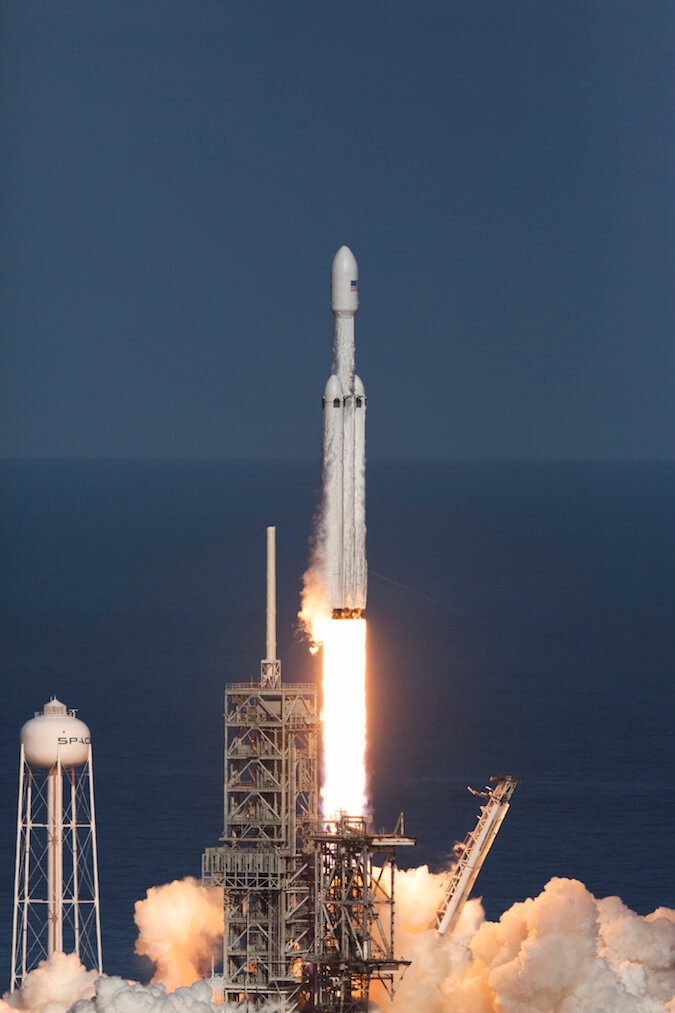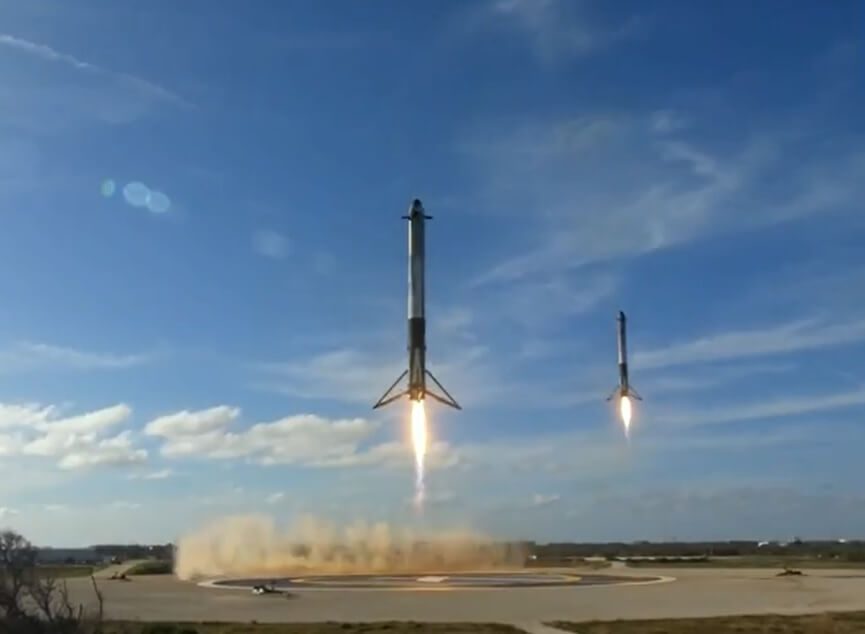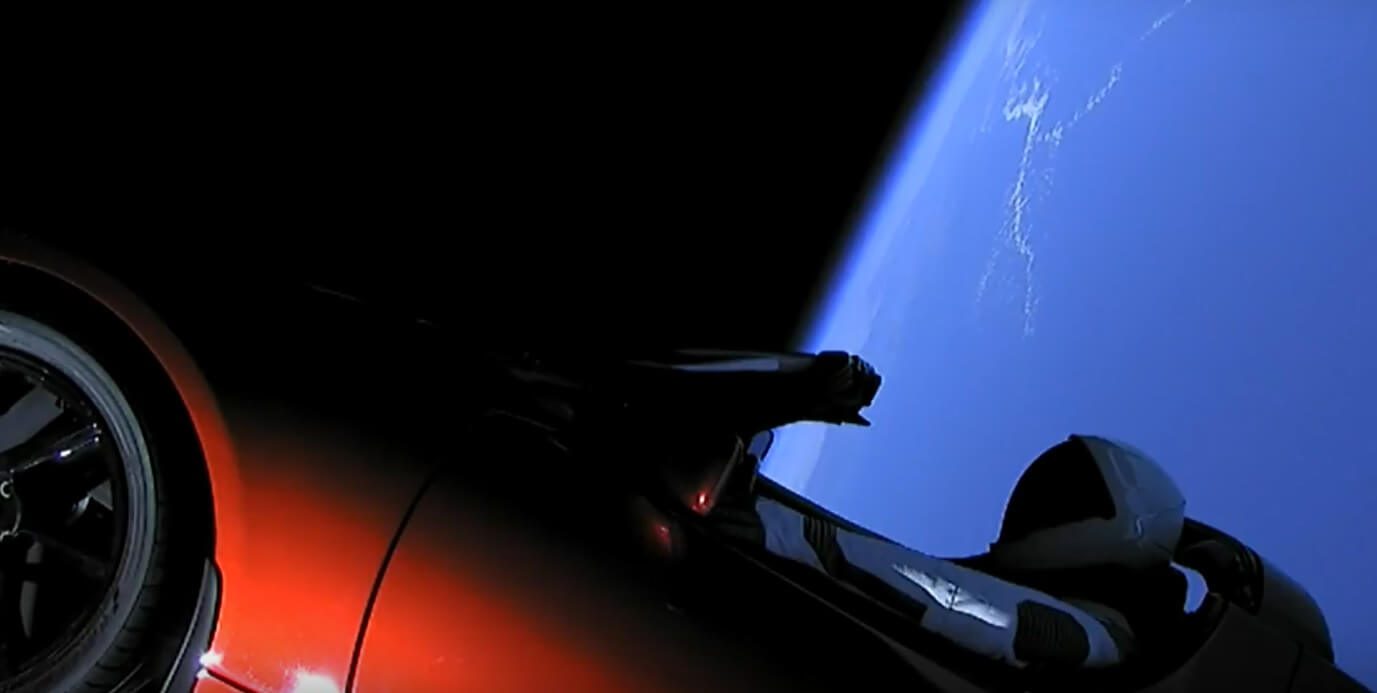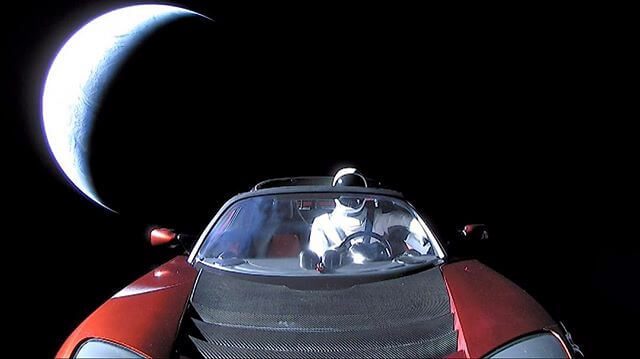The Falcon Heavy rocket has made its entrance on the world stage – and a spectacular one at that. It lifted off at 2045 GMT from the former Saturn V launch pad 39A at the Kennedy Space Centre, near Cape Canaveral in Florida. In doing so, it disproved its detractors by showing that a 27 rocket engine lift-off is doable.

Falcon Heavy launches into orbit on maiden flight. Courtesy: NASA/Kim Shiflett
Some eight minutes later the separated side boosters (which detached from the core two minutes 33 seconds into the flight) came back to Landing Zones LZ 1 and LZ 2 at Cape Canaveral. Both made a perfect landing, as if they were synchronised with each other. It really was like watching ballet!

Falcon Heavy side boosters make simultaneous synchronised landing. Courtesy: SpaceX
The Falcon 9 core first stage carried on firing as its booster siblings departed, before itself separating to make its own powered landing attempt on the drone barge, Of course I still love you, hundreds of kilometres downrange. But the first stage crashed into Atlantic after missing its landing on the drone ship 100m away due to failure of two of the three engines to ignite. The cause was later disclosed to be that the outer engines did not ignite because the ignition fluid was depleted on earlier burns. This second stage fired its way successfully into orbit. The first stage main core booster was new, but both the side booster stages had flown before on Falcon 9 flights.
This left the piece de resistance: as the fairing fell away, Elon Musk’s cherry red Tesla roadster was captured by an on-board camera, “driven” by a dummy “Starman” astronaut with “Don’t Panic” inscribed on the dashboard – sound advice for a hitchhiker ready for blast-off to voyage around the Sun. As it reached its low Earth parking orbit, SpaceX aptly broadcast Bowie’s Life on Mars song in the background.

Starman dummy astronaut prepares to drive his – or rather Elon Musk’s Tesla Roadster – around the Sun. Courtesy: SpaceX
From its 185km parking orbit (inclined at 29 degrees) at 2053 GMT (all times from SpaceX via Jonathan McDowell), and after a coast to the equator, stage 2 made its second burn at 2113 GMT to achieve a 184 x 6953 km x 29.0 degree orbit. Falcon spent two orbits of the Earth in this elliptical path. At 0230 GMT on 7 February, over Los Angeles, the stage was reignited near the perigee for the third burn to inject itself and the car into a heliocentric orbit.
This launch was a theatrical entrance for a rocket that may be destined for only a short service career. It is now confirmed, possibly as part of a deal with NASA, that the Falcon Heavy will not carry astronauts (it was being mooted as a vehicle for a “privateer” round the Moon flight). SpaceX has another very large launch system in the offing – the BFR (aka Big F***ing Rocket but now more politely known as Big Falcon Rocket) – and this will eventually replace the Falcon Heavy, and probably NASA’s SLS as well. SpaceX plans to man-rate this instead of the Falcon Heavy, and will begin suborbital test flights of preliminary versions of its reusable upper stage/transporter next year.

Never look back: Starman in his Tesla Roadstar with the Earth rapidly diminishing behind him. Courtesy: SpaceX
By the way, the most incredible thing about that vehicle is that the upper stage will be capable of being a single-stage-to-orbit rocket in itself. Its thermal protection has to be good enough to allow Mach 25 re-entries and yet light enough to fly – the hard part of such an exercise.
Nevertheless, while the BFR is the long-term future, there was no denying the Falcon Heavy its moment of glory in a mainly successful flight. It was impressive even before launch, given its 70m (229 feet) stature and a payload performance that dwarfs all rockets now flying. This “mini-giant” rocket is able to carry over 63 metric tons to low Earth orbit (LEO) – a payload 10 tons over that originally projected for the rocket .This is uncomfortably close to the 70 metric ton performance of the initial Block I versions of NASA’s own SLS heavy lifter which is nearing completion, – even though it is now expected to reach 80 metric tons plus.
Worse for NASA, in some ways, was that this new SpaceX rocket with its kerosene/LOx (liquid oxygen) consuming 27 Merlin engine lift-off was not heading to LEO as its final destination. SpaceX and Tesla car supremo Elon Musk decided instead that this first flight would be into orbit around the Sun.
While not wanting to fly a valuable “live” spacecraft on what would be a high-risk maiden voyage, the Tesla car stunt made a serious point: it showed NASA that the Falcon Heavy rocket could be used for unmanned interplanetary explorer missions, in addition to its other role as a launcher of large satellites for commercial operators and the US military.
And in being about one magnitude less in terms of launch cost, it could usurp SLS in this interplanetary role, which NASA had hoped would increase the SLS rocket’s utilisation – especially given that so few human SLS launches are planned.
Comment by David Todd: Congratulations to SpaceX for a fun but progressive launch. More seriously, however, it is a sign that time is nearly up for SLS – even before it has made its maiden flight. The Falcon Heavy would be able to replace SLS for NASA’s projected unmanned planetary missions for a tenth of the cost of an SLS. Worse, the later 150 metric ton plus SLS Block II version, with its advanced boosters, and possibly even the 105 metric ton SLS Block 1B version, could soon be overtaken by SpaceX’s 150 metric ton capable and much cheaper, all-reusable BFR. And this ignores the threats to SLS from the other side of the fence: Blue Origin’s New Glenn derivative HLV, New Armstrong.
SLS may be an overly expensive temporary rocket (its Sidemount competitor would have been a better interim choice as it would have been ready by now), but all is not lost. Given Musk’s past over-optimism with launch targets, SpaceX will probably not make its demanding schedule. Thus, for a short time, there is room (and need) for an interim heavy-lift rocket. Nevertheless, SpaceX’s BFR and Blue Origin’s New Armstrong will eventually be in a position to replace SLS entirely in, say, eight years or so.
NASA needs to get humans flying on an SLS and onto the surface of the Moon as fast as possible – or else the whole SLS programme could look like a pointless multi-billion dollar white elephant. Ideally, it should man-rate the SLS Block 1 with its Interim Cryogenic Propulsion Stage (ICPS), and then build a lunar excursion module ahead of any “Lunar Orbiting Platform Gateway”. This could be carried on a basic Apollo-like expedition using a two-launch architecture either by an SLS Block 1B with its Exploration Upper Stage (EUS), or even sooner (and cheaper) by a Block 1 using extended tanks ICPS.
By the way an ISS replacement Skylab-style space station is more urgently required in LEO ahead of any lunar space station. As it is, such a “son of Skylab” design (launched by a Falcon Heavy or SLS) could easily repurposed for the lunar role.
As it is, it may well be that NASA keeps the lunar programme for the SLS and helps Elon Musk with his Mars exploration plan via the BFR. This is a sensible approach and one that we recommend – although SLS may soon be usurped from even this lunar role.
POST SCRIPT: This column is not the only one that has doubts about the wisdom of going on with the SLS programme. Lori Garver, the former Deputy Administrator of NASA, has voiced her opposition to continuing with the SLS programme here.







